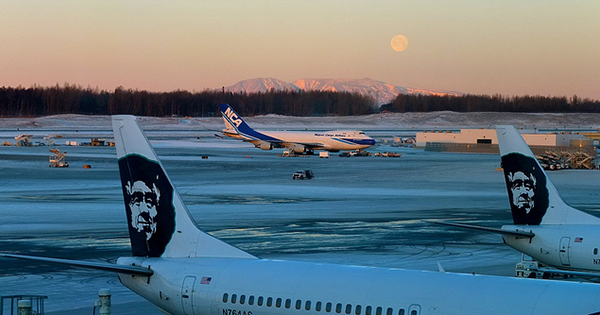
I just bought plane tickets to the East Coast to attend my younger brother’s wedding in June. Something about the process of purchasing tickets online—putting in my dates and locations, choosing seats, inputting birthdates, agreeing to pay baggage fees, and all of that—made me nostalgic for the last time I walked into a travel agency, which was in a small log building in Homer. At that time, the Anchorage Airport was still a dingy, low-slung place, not the gleaming, mall-like complex it is now, resembling any number of airports in the rest of the country. There was something endearing about those earlier days—before the three-story glass façade, before the Starbucks, before the tchotchke stores; it was a reminder that in Alaska, practicality usually trumps aesthetics.
One of the Anchorage Airport’s claims to fame is that it is nine and a half hours or less by plane to 90 percent of the industrialized world. This fact—and its location between Asia and the Lower 48—strategically places it as a cargo hub. But it was an amendment tacked onto a federal aviation bill by Alaska’s late Senator Ted Stevens—Uncle Ted, as Alaskans referred to him, because of all the gifts he brought back from Washington—that made the Ted Stevens Anchorage International Airport the fifth largest cargo hub in the world and the second largest in the country, right behind Memphis, the base for FedEx. The Anchorage Airport profits from an exemption enjoyed by nearly no other airport in the industrialized world: here, foreign cargo planes can land and transfer cargo without being subject to federal regulations. It is largely because of this loophole that when we’re at the airport we spot lots of double decker cargo airplanes from all over the world.
For a few years, two airlines operated scheduled flights to Anchorage out of the Homer Airport—one with dual-prop, dual-pilot planes, the other with a single engine and single pilot. For the latter, the pilot entered the plane by climbing across the wing, and one of the paying passengers sat co-pilot. Some people refused to take those planes in winter, when storms add extra hazards to air travel. Now that counter sits empty.
The biggest excitement at the Homer Airport in recent months is that a former pastor just opened a coffee shop there—as far as I know, the first food outfit to try to make a go of it. I’ve heard the coffee is excellent, although it’s hard to imagine the business surviving the off-season.
Because of the $250 round-trip ticket price from Homer to Anchorage, we usually drive to Anchorage at the start of a trip Outside. But I love living in a place where I can dash home from the airport between check-in and takeoff to scoop up a beloved—but forgotten—stuffed animal. Or where security lines don’t exist. Or where I can call the airline desk and find out the real touchdown time for a flight and listen for the plane on my way to pick up friends or family, knowing that it’s still in the air and that I’m not running late. Or where you can check your bags and still have time before your flight to go birding in the wetlands nearby.

